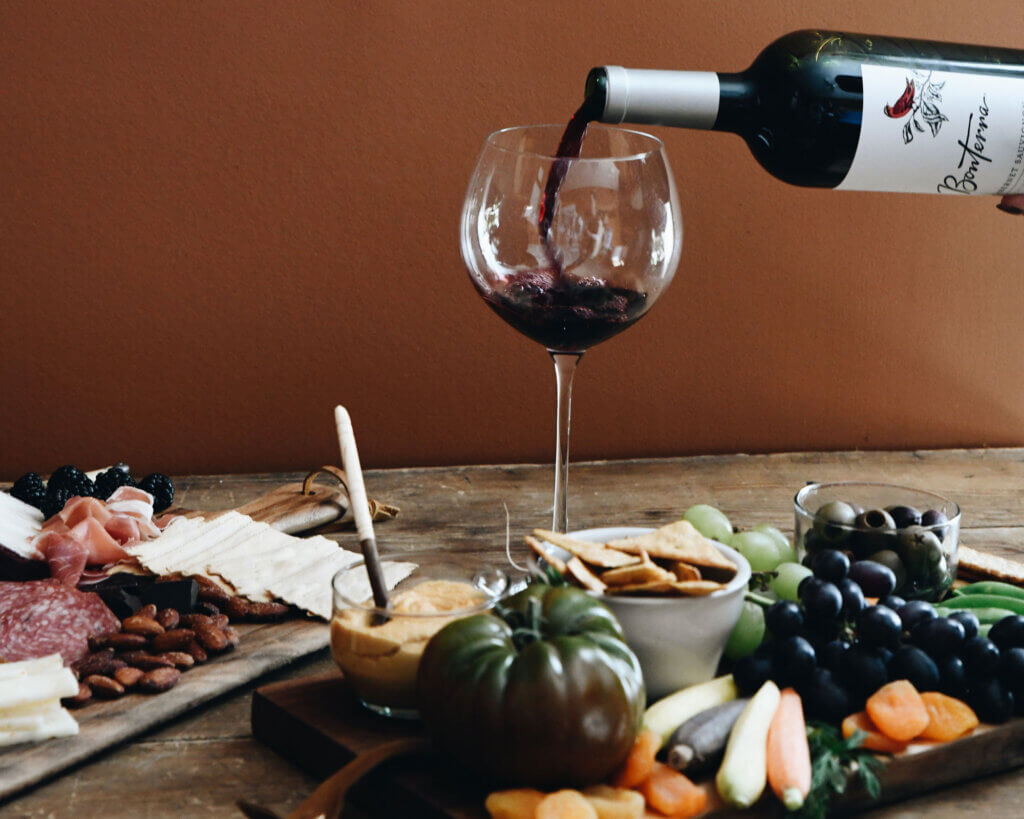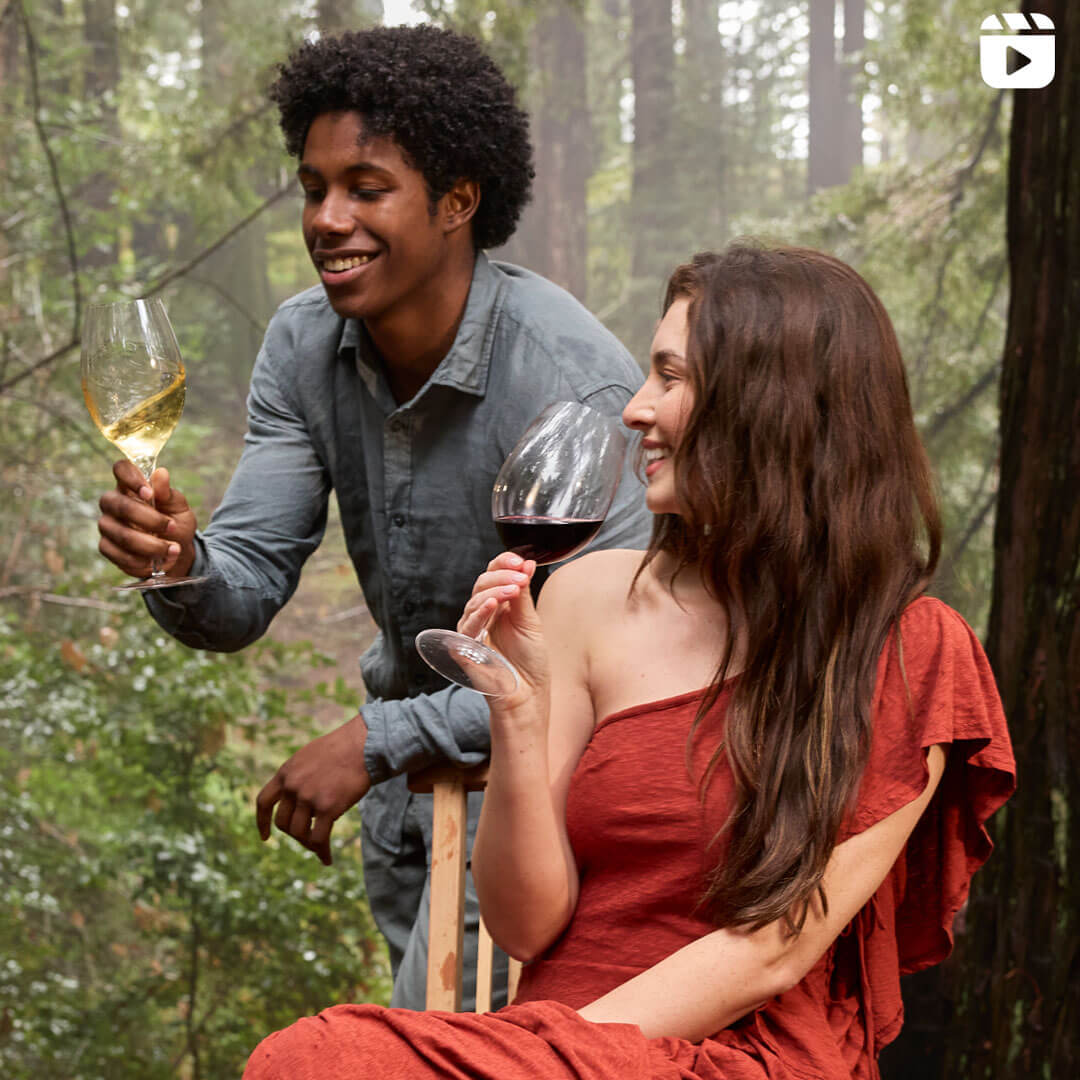The magic of a successful wine pairing is hard to overstate. A well-chosen wine can elevate even the humblest meal, and the best wine pairings unlock unexpected levels of deliciousness in both your food and your wine. There are many types of red wine – so how do you know what to pair with your meal?
In this food pairing guide, we’ll share some tips on pairing red wines with a variety of foods and cuisines, using our portfolio of award-winning Bonterra red wines as examples. Because they’re made at an organic winery with 100% certified organic grapes, they offer pure, classic expressions of their varieties – plus the confidence you’ve made the right wine choice for your body, your table, and your planet.
The Basics of Red Wine Pairing
For a long time, wine pairing wisdom was simply to pour white wines with fish and white meat, and red wines with red meat. Today, though, we recognize that reds can pair well with much more than steaks and chops. To red wine lovers, this is great news for both our health and our environment!
The key to successful red wine pairing is choosing a red blend with the right texture, intensity, acidity, sweetness, and flavor characteristics for the food you’re eating. This applies just as much to vegetarian and vegan dishes as it does to meat and fish.
Think About Texture: Body, Tannins and Structure
Most rich, toothsome dishes love a wine with a firm tannin structure, which helps to cut that richness and make the dish seem lighter. Higher-fat foods also help offset the drying effect of tannins, and spotlight the other flavors in the wine. Tannic wines frequently taste metallic when paired with fish and seafood, though, which is probably the original reason for the old “no red wine with fish” rule. Lighter dishes with silkier textures (like fish and some vegetables) are better paired with more delicately textured, less tannic wines like Pinot Noir and softer Merlots.
Matching Intensity
Intensely flavored foods (like smoked meats and vegetables, duck confit, or fatty tuna belly) will taste best with wines that have the intensity and concentration to stand up to them. If your food has a lot of subtle flavors, choose a similarly delicate wine so it won’t overwhelm your food.
Go Toe to Toe with Acidity
Acidity plays an important supporting role in all food and wine pairing. Tangy foods need tangy wines to match them—a very ripe, low-acid wine will taste terrible with a high-acid dish like tangy tomato sauce, or a hot dog slathered in mustard.
If your dinner has a nice bit of tartness to it, aim for higher-acid red blend like Pinot Noir or Sangiovese (the key grape in Chianti, not coincidentally the traditional wine match for red sauce Italian), and avoid reds with lots of ripe, luxuriously sweet fruity flavor. Dishes with extremely high levels of acidity (like sauerkraut, sour cream or vinegar-based sauces and condiments) are really better off paired with tart, tangy whites that have higher acidity than you find in reds.
How to Pair Red Wine with Spicy Foods
With spicy hot dishes, your best bet is to choose a wine with fresh acidity to keep your tastebuds from shutting down, plus some sweet fruit to help balance the burn, without a lot of tannin or alcohol. Spicy food makes both tannins and alcohol more pronounced, so we recommend reaching for low-tannin and lower-octane reds, crisp rosés, or white wines when you’re cranking up the Scoville scale.
Finally, Flavor
Once you’ve already thought about richness, intensity, acidity and spiciness, it’s time to consider the flavor profiles in your food and wine. Think about the main flavors in both partners as if they were a single mouthful – they will be – and consider whether that marriage will be a happy one. Some food flavors pair well with virtually all red wines, roasted root vegetables, mushrooms, caramelized onions, earthy legumes, smokiness, and savory umami notes. But some of these flavors are better with certain varieties. We’ll discuss some flavor affinities in more detail below.
Pairing Bonterra Red Wines with Different Cuisines
Now that we know what we’re focusing on, let’s dive in and talk about great pairings for some of the most popular red wines out there.
Cabernet Sauvignon
This world-famous red grape tends to have the most tannin and body of our red wines, and so it pairs best with richer, savory dishes that aren’t spicy (remember that big tannins and spiciness don’t mix). The typical flavors in Cabernet Sauvignon— blackberry, black currant, black cherry, and dried herbs — make a particularly great match with thyme, fennel, rosemary, bay leaf, basil, dried mint, and cinnamon.
Our Bonterra Cabernet Sauvignon is on the bolder side of medium-bodied red wine, with approachable tannins, balanced acidity, and juicy notes of blackberry and blackcurrant at the center. This makes it a versatile partner for food, playing well with herb-roasted chicken, slowly braised or caramelized vegetables, rich legume stews, and most grilled meats and veggies with a moderate amount of fat. Try it with a Persian khoresh to experience Cabernet’s affinity for herbs.
Our Estate Cabernet Sauvignon spends some time in French oak, which brings additional body, sleek textures, and subtle hints of baking spice. This would be a beautiful choice with your heartiest dishes. Think braised shanks, rich slow-simmered stews, and roasted or grilled steak and red meats. Stick-to-your-ribs vegetables braised in rich, savory stocks or olive oil also would work well, especially if they’re seasoned with Cab-loving herbs or spices.
Merlot
Merlot makes a suave, velvety red wine with softer tannins than Cabernet, medium body, and an abundance of inviting ripe fruit and plummy flavors. With that combination, it probably won’t surprise you that Merlot pairs well with a wide range of dishes! This is especially a wine to reach for with Mediterranean cuisines, where meat stews are often lighter and vegetable dishes richer. From Morocco and Spain to France, Italy, Greece, Turkey and the Middle East, Merlot is there for you. Some of the best flavor combinations with Merlot include basil, thyme, rosemary, juniper, chocolate, and coffee.
Organically farmed Bonterra Merlot showcases the grape’s generous fruit character beautifully, making it a lovely complement for dishes like roasted duck or chicken legs, mushroom pastas, hearty vegetable flatbreads, veggie burgers, and leaner red meats like grilled lamb chops or grass-fed beef. It’s also a great choice with Chinese food, especially dishes with lots of meaty or mushroom flavor.
Pinot Noir
Pinot Noir’s exceptionally silky texture, light body, fresh acidity, and aromatic fruit set it apart in the bold red wine world. The light texture and gentle tannins allow it to partner seamlessly with light meats, firm-fleshed fish and seafood (particularly salmon), and most cooked vegetables. Pinot’s bright, sweet red fruit also holds its own with a bit of spice. The earthy or smoky flavor undertones in many Pinot Noirs pair incredibly well with earthy flavors like mushroom, truffle, alliums (the onion & garlic family), and cumin, but this grape also shines with fennel, sumac, thyme and cinnamon.
Bonterra Pinot Noir is a food pairing wunderkind thanks to its light body, gentle oak vanilla, bright cherry and pomegranate flavors, and earthy nuances. This wine is brilliant with grilled meat like chicken or salmon, smoked poultry (or cheese, or fish/seafood), Thanksgiving turkey, lentil dishes, mu shu anything, Lebanese mujadara, and leaner cuts of meat like pork chops or lamb tenderloin. The nuanced, delicate aromas and refreshing acidity make it a fantastic choice for understated dishes in a range of styles, from Vietnamese and Japanese to German, northern Italian, and northern French.
Zinfandel
Zinfandel is another highly distinctive bold red wine grape, loved for its spicy and fruit-forward personality. Zin typically doesn’t have as much tannin as Cabernet or Merlot, so slots in well with slightly spicy BBQ, wild game, and many other dishes with a lot of intense flavors. This grape’s spicy boldness is particularly great with foods featuring white or black pepper, allspice, cinnamon, cloves, rosemary, fennel, juniper, and smoky Spanish pimentón.
Bonterra Zinfandel showcases Zin’s spicy red and blue fruit signature, blended with a bit of Petite Sirah for more complex violet aromas. Balanced acidity, soft tannins, and some sweet oak aromas make this wine a knockout with Korean BBQ, umami-rich Chinese dishes, spicy Southern Italian red sauces, and aromatic Middle Eastern dishes like za’atar flatbreads or gyros.
Tips for Perfecting Your Pairings
Naturally, there are a few kitchen tips and tricks that can help the food you’re cooking taste better with the red wine you’re drinking. Here are a few of our go-to techniques to help create a better red wine pairing, whether you’re cooking vegetarian, vegan, pescatarian or omnivorous. We hope they’ll help you transform your red wine pairings from good to divine!
Don’t Fear the Fat
As we already discussed, the food’s richness is key to a successful red wine pairing, but this doesn’t mean you can only enjoy rich meat while drinking red. Many, many other dishes can become more red-wine aligned with a well-chosen cooking fat, finishing oil, and/or fat-based sauce. Some of the tastiest fats for red wine pairings are olive oil, coconut oil, coconut milk, sesame oil, pumpkin seed oil, and grapeseed oil. (And butter, of course, which tastes amazing with just about everything.) Sometimes all you need to make a red pairing sing is another little drizzle of oil over the top.
Add Some Umami
A lot of foods that might not be natural partners for red wine (hello, green salad!) can be coaxed to greatness with a bit of umami. This earthy flavor and savory taste helps add depth and a sense of richness, which means your food is more delicious regardless of what wine you’re drinking. Think about working in some miso paste, soy sauce, fish sauce, bonito flakes, fermented black bean paste, doubanjan, furikake, aged cheeses like Parmigiano-Reggiano or Gruyère, dried mushrooms, or tomato paste. Manufactured umami sources (cured meats, aged cheeses, and fermented pastes and sauces) are high in sodium, though, so dial back the salt you would normally use when working with these. For your next mixed green salad, try making an umami-rich dressing with 1 teaspoon of fish sauce, 2 tablespoons of olive oil, 1 finely grated garlic clove on the smaller side, freshly ground pepper, and a tiny squeeze of lemon. Your lettuce is ready for red wine!
Pairing Vegetables with Red Wine
We all know we need to be eating more vegetables, but most food pairing guides fixate on the (usually meat or fish) protein with an occasional mention of mushrooms. The truth is, you don’t have to choose between having a complementary pairing and eating more plant-based foods. Most vegetables can be prepared in ways that make them delicious with red wine! The key is preparing them in ways that flatter red wine’s robust textures and lower acidity.
Slow Cooking
Slow, gentle cooking with a good glug of oil works wonders with onions, garlic, beets, winter squashes, carrots, celery root, turnips, and even leafy greens. Caramelizing plants’ natural sugars this way brings out complex, rich flavors that help to bridge the gap with red wines. Remember not to skimp on the fat and umami if you’re wanting to pair them with a robust, structured red like Cabernet. A final drizzle of olive oil, shower of grated Parmesan, or dollop of pesto can get you there.
Grilling and Charring
You don’t always have to cook vegetables slowly for red wine pairings. Sometimes a quick bit of charring can take your vegetable pairings to the next level. Besides the tried-and-true bell peppers, portobello mushrooms, and onions, try throwing fresh fruit like peaches or mango and even heads of romaine lettuce on the grill before you put them in your salad. Grilled cabbage (cut into wedges through the root) is also incredibly delicious! Really, most grilled veggies will make a great partner for red wine, especially if they’re finished with some umami-rich fat. Miso butter – one part white miso paste, mixed with three parts butter or vegan equivalent – is a particular favorite.
Experience Red Wine Excellence
There is no substitute for experience when it comes to pairing wine. Everyone has their own set of personal preferences and aversions in wine and food – just as with everything else. The only way to find out the best wine pairing for you is to try a few different things and see what really clicks, including exploring our red blend wines. Check out our wine tasting tips to ensure your experimenting goes smoothly. Use Bonterra’s organically farmed red wines to guide your experiments, and don’t be afraid to try something crazy. With Bonterra Vineyard, you are sure to find the perfect wine online. Bon appétit and happy pairing!




